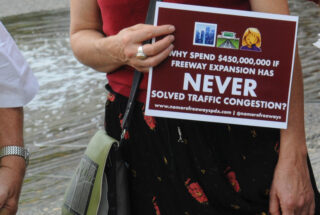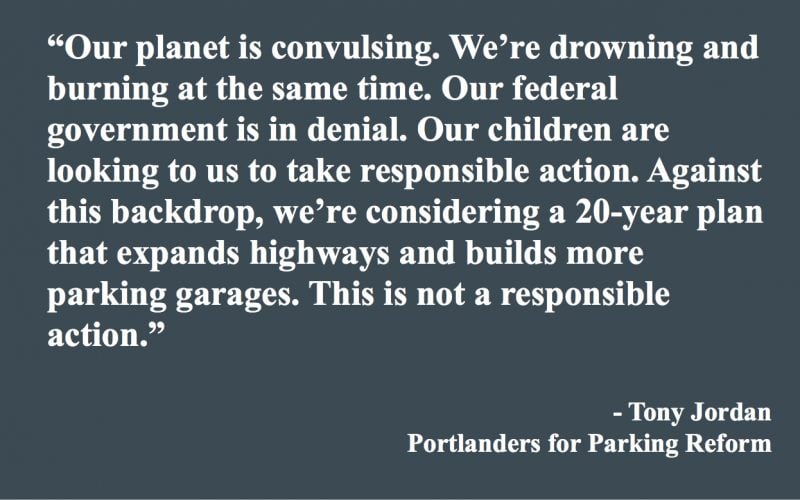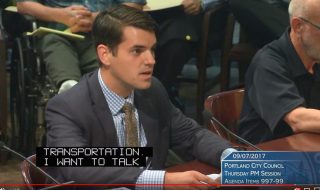
(Photo: J. Maus/BikePortland)
On Thursday afternoon Portland City Council members got an earful of opposition to the most expensive project in their 20-year Central City 2035 plan: The controversial proposal to invest $450 million to add new lanes and shoulders on I-5 between I-84 and I-405 through the Rose Quarter.
Council hosted the public hearing as part of their effort to adopt an updated Central City plan, which they hope to vote on in March. In recent weeks, No More Freeway Expansions — a grassroots coalition of neighborhood groups, nonprofit organizations and Portlanders who oppose the I-5 widening project — seized on the hearing as an opportunity to encourage council to remove it from the plan.
“We must implement the one and only proven method for combating traffic congestion — value pricing — sooner rather than later.”
— Mayor Ted Wheeler
Mayor Ted Wheeler and his colleagues on council would have to buck significant political momentum for the project if they chose to go along with the coalition. The Oregon Legislature agreed to set-aside $30 million per year in gas tax revenue for the project starting in 2022 and the Oregon Department of Transportation has been champing at the bit to expand I-5 through the Rose Quarter for decades. They feel its current cross-section causes too many crashes and too much congestion. (For a great overview of the project read this week’s Portland Mercury article.)
In opening remarks before public testimony began at the hearing today, Mayor Wheeler said he supports Commisisoner Dan Saltzman’s position on the project (Saltzman was not present). Saltzman released a statement this week supporting the project; but with one key condition: that “value pricing” (a.k.a. congestion pricing or tolling) be done “in advance… to ensure maximum congestion relief and overall environmental benefits.”
“I wholeheartedly support [Saltzman’s expectations of the project],” Wheeler said today, “We must implement the one and only proven method for combating traffic congestion — value pricing — sooner rather than later.”
Wheeler added that we can expect Saltzman’s office to bring a resolution specific to this project to city council in the coming weeks.
When it came time to hear public testimony on the project, those who oppose it clearly won the day. Dozens of people spoke against it and many others didn’t get a chance to testify due to time contraints.
Only two four people testified in support of the project: One was an invited member of the Portland Planning Commision and two were ODOT staffers.
Noted transportation reform advocate and Vice-Chair of the Portland Planning Commission Chris Smith testified today as a leader of the No More Freeways coalition. “We believe the project is ill-advised,” he said. Smith told council members that he has a list of 24 Comprehensive Plan policies that it directly contradicts. Smith said it doesn’t address safety (the crashes ODOT points to are primarily non-injury fender-benders), goes against greenhouse gas and emission reduction policies, and it invests in what the city’s adopted plans say is the lowest priority in our entire system: encouraging single-occupancy vehicle use.
And with climate change on everyone’s mind, Smith ended with this: “Making a half-billion dollar investment that sends climate in the wrong direction is not supportable.”
Advertisement

Echoing that theme, parking reform advocate Tony Jordan opened his testimony with this blunt assessment:
“Our planet is convulsing. We’re drowning and burning at the same time. Our federal government is in denial. Our children are looking to us to take responsible action. Against this backdrop, we’re considering a 20-year plan that expands highways and builds more parking garagaes. This is not a responsible action.”
Audubon Society of Portland Conservation Director Bob Sallinger said, “I strongly enourage you to go beyond just the congestion pricing and eliminate this project altogether.”

The two ODOT staffers who testified in support of the project mostly stuck to their scripts. ODOT Region 1 Government Liaison Andrew Plambeck described the freeway elements of the project as, “Adding auxiliary lanes and shoulders,” and said the project will result in, “Important safety and operational benefits without adding any additional through lanes.” He also touted the surface street elements of the plan like the “Innovative lid” that would be built over I-5, “Creating a new open space and better east-west surface connections.” Plambeck also mentioned the new carfree bridge that would be built across I-5 at Clackamas Street that would be, “A key connection for the city’s Green Loop concept.”
When Commissioner Amanda Fritz asked Plambeck if the surface street elements could still get state funding without doing the freeway widening, Plambeck said no. “That’s not what the legislature has provided funding for.”
“So we can’t just use the money for something else?” Fritz asked. “No, I don’t believe so,” Plambeck said.
“This was purely a highway expansion project from the start… assurances of basic surface improvements along with the freeway widening was simply an effort to sugarcoat the highway project for skeptical Portlanders.”
— Steve Bozzone
Supporting Plambeck was another ODOT employee. Public Policy and Commmunity Affairs Manager Shelli Romero talked up the agency’s “environmental and public process” which will include, “a robust understanding, research and engagement strategy of the historically wronged African-American community and other communities of color.”
“We understand the historic inequity concerns and will engage all communities in this project,” Romero promised.
Surprisingly, she also attempted to impugn congestion pricing in general with a strange and unfounded jab. “Several people have brought up the issue of congestion pricing,” she said, “but there has been very little mention about how equity considerations, when you look at congestion pricing on this section of I-5, would be taken into consideration.” This is an odd statement from the staffer of an agency that has a mandate from the legislature to create and implement a congestion pricing program.
And Romero’s promises about a “robust” public process that will respect neighboring communities was called into question by the testimony of Portlander Steve Bozzone, who was a member of ODOT’s advisory committee when this project was initially vetted back in 2012.
Bozzone (who also happens to be BikePortland’s web guy) told council he was a member of the I-5 Rose Quarter project’s stakeholder advisory committee. “I participated in the process every step of the way, and the process was abysmal,” he said. “The local community surrounding the project was not well represented and was mostly ignored.”
Here’s more from Bozzone’s stinging criticisms of ODOT’s public process:
“Albina’s black comminity, who bore the brunt of the negative effects of I-5 bulldozing through their neighborhoods were curiously not at the table. Freight companies, industry and developers dominated every meeting. When I tried to build relationships with ODOT staffers at design charettes and ask for their business cards, they laughed at me.
This was purely a highway expansion project from the start. ODOT knew what they were doing. They kicked things off by proposing huge flying-diamond interchanges and giant off-ramps. Really scary stuff! PBOT was in the room, but ODOT was in the driver’s seat. Alternate proposals that didn’t include freeway widening were quickly swept into ODOT’s recycle bin and deemed out-of-scope.
The effect is that we are supposed to be relieved ODOT didn’t bulldoze half of the Lloyd District. Including assurances of basic surface improvements along with the freeway widening was simply an effort to sugarcoat the highway project for skeptical Portlanders. It is a myth we can’t improve the surface street conditions without the highway portions [of the project]. We do not have to accept freeway expansions in the urban core as the ticket to surface improvements. There are no guarantees the surface improvements will be funded or delivered. Try tolling first.”
While this project is a far cry from the Mt. Hood Freeway once proposed in the 1970s, it has brought some of the veterans of that fight back to the fore. One of them is Ron Buel (who was also instrumental in organizing to remove Harbor Drive and replace it with Waterfront Park).
Buel testified Thursday and had a clear message for Mayor Wheeler and the rest of council: “Get some guts. Have some backbone.”
The coalition that defeated the Mt. Hood Freeway got the federal funding transferred to light rail instead. “I was there, I was a part of that,” Buel shared. “And the city council and Mayor Goldschmidt didn’t have a low-level bureaucrat from ODOT telling them what they could or couldn’t do with that money. They went to work and fought for it and we got it done and we didn’t built that freeway.”
Whether council muster similar strength this time around remains to be seen.
You can submit written testimony on the Central City 2035 plan until 5:00 pm on September 15th. Council is scheduled for a vote on the transportation elements of the plan on October 18th. Also note that ODOT has launched a new website for the project and announced an open house for Tuesday September 12th in northeast Portland.
— Jonathan Maus: (503) 706-8804, @jonathan_maus on Twitter and jonathan@bikeportland.org
Never miss a story. Sign-up for the daily BP Headlines email.
BikePortland needs your support.

